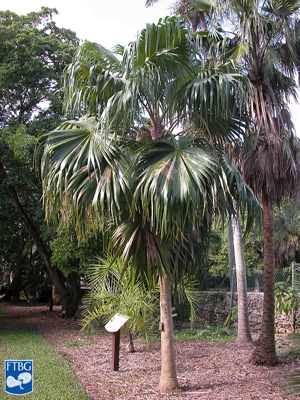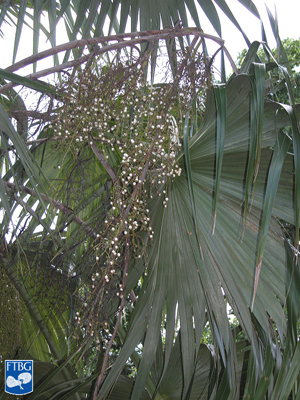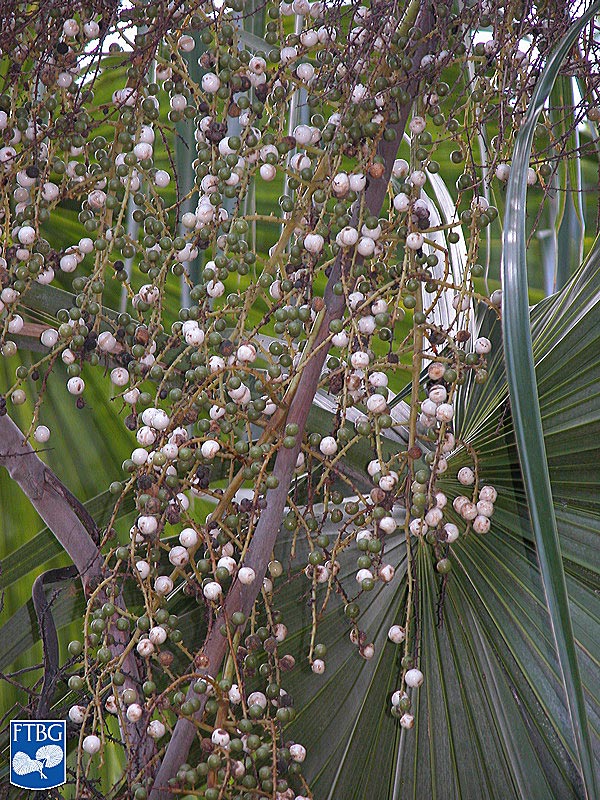Thrinax excelsa
|
Thrinax excelsa habit. Photograph courtesy of Fairchild Tropical Botanical Garden, Guide to Palms http://palmguide.org/index.php |
|
Thrinax excelsa leaf with fruits. Photograph courtesy of Fairchild Tropical Botanical Garden, Guide to Palms http://palmguide.org/index.php |
|
Thrinax excelsa fruits. Photograph courtesy of Fairchild Tropical Botanical Garden, Guide to Palms http://palmguide.org/index.php |
Common name
broad thatch, Jamaican thatch palm
Description
Stems: Solitary, erect gray to brown stems, to 11 m tall, up to 20 cm in diameter, with faint, incomplete rings from leafleaf:
in palms -- the leaf blade (which is usually divided into leaflets or leaf segments), the petiole (or leaf stalk) and the sheath (which forms the attachment of the leaf to the stem)
scars. Stems of younger individuals are covered with matted fibers from old leafleaf:
in palms -- the leaf blade (which is usually divided into leaflets or leaf segments), the petiole (or leaf stalk) and the sheath (which forms the attachment of the leaf to the stem)
bases, as are the upper reaches of older palms. Older palms also have an expanded root bossboss:
expanded mass of exposed roots at the root initiation zone
at the base of the stem. Leaves: Palmatepalmate:
like the palm of a hand; fan palms have palmate leaves that are usually divided into leaf segments arising from a central point, although a fan palm may have entire leaves (e.g., <em>Licuala grandis</em>)
, induplicateinduplicate:
Most palm leaflets or leaf segments are obviously folded. If the folds create a V-shape, with the midrib lower than the margins (so that rain might fall "into a valley"), the folding is induplicate.
, unarmed, forming a dense canopy; each with a circular blade 1.5-2 m across, divided at least half its length by numerous, lanceolatelanceolate:
term to describe leaves and leaflets that are longer than wide and widest below the mid-point; lance-shaped
segments with drooping tips and having a petiole as long as or longer than the blade. The upper leafleaf:
in palms -- the leaf blade (which is usually divided into leaflets or leaf segments), the petiole (or leaf stalk) and the sheath (which forms the attachment of the leaf to the stem)
surface is deep, glossy green; the undersurface, gray and waxy; midrib and marginal ribs, prominent. The fibrous leafleaf:
in palms -- the leaf blade (which is usually divided into leaflets or leaf segments), the petiole (or leaf stalk) and the sheath (which forms the attachment of the leaf to the stem)
sheath is split at the base. Flowers and fruits: Inflorescenceinflorescence:
the reproductive structure of a flowering plant, including palms, consisting of flowers and associated bracts
is longer than the leaves, emerging through split leafleaf:
in palms -- the leaf blade (which is usually divided into leaflets or leaf segments), the petiole (or leaf stalk) and the sheath (which forms the attachment of the leaf to the stem)
bases, arching and branched to two orders. The spicy-fragrant pinkish purple flowers have both male and female parts. The fruits are small (8-11 mm in diameter), spherical and white when ripe; pedicelpedicel:
a floral stalk
more than 1 mm long.
Diagnostic features
Solitary, upright palm with a dense canopy of palmatepalmate:
like the palm of a hand; fan palms have palmate leaves that are usually divided into leaf segments arising from a central point, although a fan palm may have entire leaves (e.g., <em>Licuala grandis</em>)
leaves, waxy gray on the underside; leafleaf:
in palms -- the leaf blade (which is usually divided into leaflets or leaf segments), the petiole (or leaf stalk) and the sheath (which forms the attachment of the leaf to the stem)
sheaths that split at the base; and small, white fruit.
May be confused with
Coccothrinax species, but they have chocolate brown to purple black fruit and leafleaf:
in palms -- the leaf blade (which is usually divided into leaflets or leaf segments), the petiole (or leaf stalk) and the sheath (which forms the attachment of the leaf to the stem)
bases that do not split.
Distribution
Native to Jamaica
Additional comments
This palm is a striking ornamental with large leaves and fragrant flowers.
Scientific name
Thrinax excelsa Lodd. ex Grisb.
Family
Arecaceae/Palmae
Synonyms
Thrinax rex Britton & Harris





